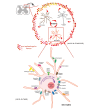Targeting the Microglial Signaling Pathways: New Insights in the Modulation of Neuropathic Pain
- PMID: 27281131
- PMCID: PMC5427777
- DOI: 10.2174/0929867323666160607120124
Targeting the Microglial Signaling Pathways: New Insights in the Modulation of Neuropathic Pain
Abstract
The microglia, once thought only to be supporting cells of the central nervous system (CNS), are now recognized to play essential roles in many pathologies. Many studies within the last decades indicated that the neuro-immune interaction underlies the generation and maintenance of neuropathic pain. Through a large number of receptors and signaling pathways, the microglial cells communicate with neurons, astrocytes and other cells, including those of the immune system. A disturbance or loss of CNS homeostasis causes rapid responses of the microglia, which undergo a multistage activation process. The activated microglia change their cell shapes and gene expression profiles, which induce proliferation, migration, and the production of pro- or antinociceptive factors. The cells release a large number of mediators that can act in a manner detrimental or beneficial to the surrounding cells and can indirectly alter the nociceptive signals. This review discusses the most important microglial intracellular signaling cascades (MAPKs, NF-kB, JAK/STAT, PI3K/Akt) that are essential for neuropathic pain development and maintenance. Our objective was to identify new molecular targets that may result in the development of powerful tools to control the signaling associated with neuropathic pain.
Figures






Similar articles
-
Bone marrow mesenchymal stem cells upregulate PI3K/AKT pathway and down-regulate NF-κB pathway by secreting glial cell-derived neurotrophic factors to regulate microglial polarization and alleviate deafferentation pain in rats.Neurobiol Dis. 2020 Sep;143:104945. doi: 10.1016/j.nbd.2020.104945. Epub 2020 May 16. Neurobiol Dis. 2020. PMID: 32428552
-
Mesenchymal stem cell-derived extracellular vesicles carrying miR-99b-3p restrain microglial activation and neuropathic pain by stimulating autophagy.Int Immunopharmacol. 2023 Feb;115:109695. doi: 10.1016/j.intimp.2023.109695. Epub 2023 Jan 11. Int Immunopharmacol. 2023. PMID: 36638658
-
Following nerve injury neuregulin-1 drives microglial proliferation and neuropathic pain via the MEK/ERK pathway.Glia. 2011 Apr;59(4):554-68. doi: 10.1002/glia.21124. Epub 2011 Jan 6. Glia. 2011. PMID: 21319222 Free PMC article.
-
Microglia in the spinal cord and neuropathic pain.J Diabetes Investig. 2016 Jan;7(1):17-26. doi: 10.1111/jdi.12379. Epub 2015 Jun 23. J Diabetes Investig. 2016. PMID: 26813032 Free PMC article. Review.
-
P2 receptors, microglial cytokines and chemokines, and neuropathic pain.J Neurosci Res. 2017 Jun;95(6):1319-1329. doi: 10.1002/jnr.23816. Epub 2016 Jul 4. J Neurosci Res. 2017. PMID: 27376880 Review.
Cited by
-
Advances in Neuropathic Pain Research: Selected Intracellular Factors as Potential Targets for Multidirectional Analgesics.Pharmaceuticals (Basel). 2023 Nov 17;16(11):1624. doi: 10.3390/ph16111624. Pharmaceuticals (Basel). 2023. PMID: 38004489 Free PMC article. Review.
-
Transcriptome Changes In Dorsal Spinal Cord Of Rats With Neuropathic Pain.J Pain Res. 2019 Nov 8;12:3013-3023. doi: 10.2147/JPR.S219084. eCollection 2019. J Pain Res. 2019. PMID: 31807058 Free PMC article.
-
Mirogabalin Decreases Pain-like Behaviors by Inhibiting the Microglial/Macrophage Activation, p38MAPK Signaling, and Pronociceptive CCL2 and CCL5 Release in a Mouse Model of Neuropathic Pain.Pharmaceuticals (Basel). 2023 Jul 19;16(7):1023. doi: 10.3390/ph16071023. Pharmaceuticals (Basel). 2023. PMID: 37513935 Free PMC article.
-
Autotaxin⁻Lysophosphatidic Acid Signaling in Alzheimer's Disease.Int J Mol Sci. 2018 Jun 21;19(7):1827. doi: 10.3390/ijms19071827. Int J Mol Sci. 2018. PMID: 29933579 Free PMC article. Review.
-
Biphalin, a Dimeric Enkephalin, Alleviates LPS-Induced Activation in Rat Primary Microglial Cultures in Opioid Receptor-Dependent and Receptor-Independent Manners.Neural Plast. 2017;2017:3829472. doi: 10.1155/2017/3829472. Epub 2017 May 10. Neural Plast. 2017. PMID: 28573049 Free PMC article.
References
-
- Merskey H., Bogduk N. Classification of Chronic Pain. Seattle: IASP Press; 1994.
-
- Coyle D.E. Partial peripheral nerve injury leads to activation of astroglia and microglia which parallels the development of allodynic behavior. Glia. 1998;23:75–83. - PubMed
-
- Dworkin R.H., O’Connor A.B., Audette J., Baron R., Gourlay G.K., Haanpää M.L., Kent J.L., Krane E.J., Lebel A.A., Levy R.M., Mackey S.C., Mayer J., Miaskowski C., Raja S.N., Rice A.S., Schmader K.E., Stacey B., Stanos S., Treede R.D., Turk D.C., Walco G.A., Wells C.D. Recommendations for the pharma-cological management of neuropathic pain: an overview and literature update. Mayo Clin. Proc. 2010;85:S3–S14. - PMC - PubMed
-
- Kalso E., Allan L., Dellemijn P.L., Faura C.C., Ilias W.K., Jensen T.S., Perrot S., Plaghki L.H., Zenz M. Recommendations for using opioids in chronic non-cancer pain. Eur. J. Pain. 2003;7:381–386. - PubMed
-
- Kalso E., Edwards J.E., Moore R.A., McQuay H.J. Opioids in chronic non-cancer pain: Systematic review of efficacy and safety. Pain. 2004;112:372–380. - PubMed
Publication types
MeSH terms
Substances
LinkOut - more resources
Full Text Sources
Other Literature Sources

